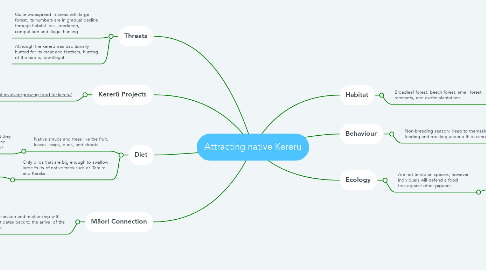Attracting native Kererū
by Lucy Goslin


1. Diet
1.1. Native shrubs and trees like the fruit, leaves, twigs, buds, and shoots.
1.1.1. When they feast heavily on ripe fruit they become very full (and even drunk) and have been known to fall out of trees!
1.2. Only birds that are big enough to swallow large fruits of native trees such as Taraire and Karaka.
1.2.1. When they pass a meal, they leave a small dropping which acts as fertiliser.
2. Māori Connection
2.1. Strong connection and relationship with Kereru that dates back to the arrival of the first canoes.
2.1.1. Use to be an important food source for Māori.
2.1.2. Plenty of Maori Iwi hold a particular relevance for Kereru, Ngāi Tahu for example features in tribal myths about the demigod- Māui.
3. Kererū Projects
3.1. http://kererudiscovery.org.nz/get-involved/growing-food-for-kereru/
4. Threats
4.1. Quite widespread in areas with large forest, its numbers are in gradual decline through habitat loss, predation, competition and illegal hunting.
4.2. Although the kererū was traditionally hunted for its meat and feathers, hunting of the bird is now illegal.
5. Habitat
5.1. Broadleaf forest, beech forest, small forest remnants, and exotic plantations.
5.1.1. Areas fairly well covered with trees (woods and plantations).
6. Behaviour
6.1. Non-breeding season: Keep to themselves, feeding and roosting under a thick canopy
6.1.1. Breeding season: Perching on top of trees.
7. Ecology
7.1. Are not territorial species, however individuals will defend a food tree against other pigeons.
7.1.1. Fights involve hitting each other with their wings while flapping about in flight.

